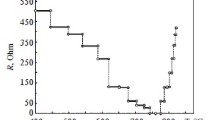A study was carried out on the effect of the carbonization temperature of dehydrated polyvinyl alcohol fibers on their electrical resistance at room temperature. A relationship was found between the electrical resistance and an increase in the carbonization temperature. A sharp drop in the specific volume electrical resistance of elementary carbon fibers to ultra low values not exceeding 0.193·10-3 mΩ·cm is found upon reaching a critical carbonization temperature. Minimum electrical resistance is found for the temperature range 743-775°C. A model is proposed for the physicochemical processes in the fiber system leading to the behavior discovered.

Similar content being viewed by others
References
Great Soviet Encyclopedia [Electronic resource] [in Russian]: https://slovar.cc/enc/bse/2030843.html (access date October 11, 2019).
S. N. Ushakov, Polyvinyl Alcohol and Its Derivatives [in Russian], vol. 2, Akademiya Nauk SSSR, Moscow-Leningrad (1960).
V. S. Smirnov, K. E. Perepelkin, and L. I. Fridman, New Industrial Chemical Fibers [in Russian], Leningrad Branch, All-Union Paper and Pulp Industry Research Institute (with associated pilot plant) (1973).
D. V. Petkieva, E. K. Golubev, et al., Doklady Chemistry, 477, No. 2, 274-277 (2017).
S. I. Senkevich, T. V. Druzhinina, et al., Khimiya Tv. Topliva, No. 1, 51-58 (2007).
J. A. Fernandez, T. Morishita, et al., J. Power Sources, 175, 675-679 (2008).
V. A. Lysenko, Scientific Basis for the Creation of Electrically-Conducting Porous Composites. Theory and Practice [in Russian], Palmarium Academic Publishers (2015): ISBN 978-3-659-60150-7.
V. A. Lysenko, Systematic Design of Carbon Composite Materials [in Russian], Palmarium Academic Publishers (2018), ISBN 978-620-2-38124-6.
V. A. Lysenko, M. V. Kriskovets, and S. V. Burinskii, Reports to the Sixteenth St. Petersburg International Conference on Regional Information Technology (RI-2018) [in Russia], St. Petersburg Society of Computer Science, Information Technology and Telecommunication Networks, St. Petersburg (2018), pp. 343-345.
V. A. Lysenko and M. V. Kriskovets, Reports to the Fifth International Scientific Conference on Prospects in the Development of Russian Information Technology [in Russian], Sevastopol State University, Sevastopol (2019), pp. 396-397.
A. A. Konkin, Carbon and Other Flame-Resistant Fibers [in Russian], Khimiya, Moscow (1974).
V. Ya. Varshavskii, Carbon Fibers [in Russian], Varshavskii, Moscow (2007).
R. M. Levit, Electrically-Conducting Chemical Fibers [in Russian], Khimiya, Moscow (1986).
U. K. Fatema, U. J. Uddin, et al., Text. Res. J., 81, No. 7, 659-672 (2010).
M. Yazdanpanah, R. Mehdinavaz, et al., The Eighth International Chemical Engineering Congress & Exhibition (IChEC), Kish, Iran (2014), pp. 1-4.
I. Yu. Prosanov, Fizika Tverd. Tela, 53, No. 4, 824-827 (2011).
V. A. Lysenko, M. V. Kriskovets, et al., Dizain, Materialy, Tekhnologiya, No. 5(40), 56-59 (2015).
V. A. Lysenko, M. V. Kriskovets, and P. Yu. Sal’nikova, Khim. Volokna, No. 5, 9-15 (2015).\
GWINSTEK [Electronic Resource] [in Russian], https://gwinstek.com/cn-GB/products/detail/GOM-802 (access date October 11, 2019).
A. A. Konkin, Heat-Stable, Flame-Resistant and Noncombustible Fibers [in Russian], Khimiya, Moscow (1978).
V. A. Lysenko and M. V. Kriskovets, Khim. Volokna, No. 4, 28-35 (2018).
M. V. Kriskovets, V. A. Lysenko, and T. D. Andreichikova, Khim. Volokna, No. 4, 23-27 (2017).
V. K. Zaporozhets, S. I. Kurbatova, and N. L. Manuilova, Handbook for Engineers, Technicians and Students [in Russian], ONTI NKTP, Moscow-Leningrad (1936),
ISOKhIM. OAO Svetlogorsk Khimvolokno [Electronic Resource] [in Russian]: http://www.sohim.by/rus/production/carbon/taw/ (access date October 3, 2019).
Torayca [Electronic Resource] [in Russian], http://www.torayca.com (access date October 11, 2019).
M. V. Kriskovets, V. A. Lysenko, et al., Zh. Prikl. Khim., 91, No. 1, 28-35 (2018).
V. A. Lysenko and M. V. Kriskovets, Khim. Volokna, No. 2, 40-53 (2019).
M. Tinkham, Introduction to Superconductivity, McGraw-Hill, New York (1975).
V. V. Shmidt, Introduction to the Physics of Superconductors [in Russian], Moscow Center for Continuing Mathematical Education MTsNMO, Moscow (2000).
L. N. Cooper, Physical Review, 104, No. 4, 1189-1190 (1956).
V. A. Kabanov, Encyclopedia of Polymers [in Russian], vol. 2, Sovetskaya Éntsiklopediya, Moscow (1974).
S. S. Shatalin, Aspects of the Thermolysis of Polyvinyl Alcohol in Fire-Resistant Composites, Technological Sciences Candidate’s Dissertation [in Russian], St. Petersburg State Institute of Cinema and Television SPbGIKiT, St. Petersburg (2015).
P. S. Sotnikov, G. I. Distler, et al., Reports to the Conference on Problems of the Physicochemical Mechanics of Fibrillar and Porous Dispersed Structures and Materials [in Russian], Zinatne, Riga (1967), pp. 119-124.
I. Yu. Prosanov and N. F. Uvarov, Fizika Tverd. Tela, 4, No. 2, 393-396 (2012).
M. É. Rozenberg, Vinyl Acetate Polymers [in Russian], Khimiya, Leningrad (1983).
R. R. Heimann, S. E. Evsyukov, and I. Karvan, Carbyne and Carbynoid Structures, Springer (1999).
J. A. Januszewski and R. R. Tykwinski, Chem. Soc. Rev., No. 9, 3184-3203 (2014).
M. M. Yildizhan, D. Fazzi, et al., J. Chem. Phys., 134, No. 12, 124512 (2011).
A. Milani, A. Lucotti, et al., J. Phys. Chem. C, 115, No. 26, 12836-12843 (2011).
I. V. Shakhova and E. A. Belenkov, Vestnik Chelyabinsk. Gos. Univ., No. 12, 33-40 (2010).
M. Weimer, W. E. Hieringer, et al., Chem. Phys., 309, No. 1, 77-87 (2005).
A. Milani, M. Tommasimi, et al., Beilstein J. Nanotechnology, No. 6, 480-491 (2015).
Author information
Authors and Affiliations
Corresponding author
Additional information
Translated from Khimicheskie Volokna, Vol. 51, No. 5, pp. 26-31, September-October, 2019.
Rights and permissions
About this article
Cite this article
Lysenko, V.A., Kriskovets, M.V. & Burinskii, S.V. Electrical Resistance of Carbonized Polyvinyl Alcohol Fibers. Fibre Chem 51, 350–356 (2020). https://doi.org/10.1007/s10692-020-10110-z
Published:
Issue Date:
DOI: https://doi.org/10.1007/s10692-020-10110-z




